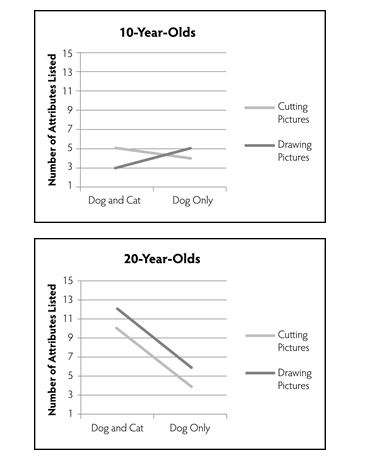RESEARCH STUDY 11.2
(The first paragraph is repeated from earlier. The second paragraph is specific to the new set of questions. The first paragraph is necessary to set up the original study.)
Dr. Elder was interested in the way people recognize objects as members of categories. For example, what makes us recognize a dog as being a dog and not a cat? More specifically, he was curious as to whether people think about categories in a more complex way if they contemplate an "opposite" category first. For example, does a person think more differently about the category of "southern" if they are also thinking about the category of "northern"? He is also curious as to whether people categorize differently if they are exposed to category members compared with generating category members. Dr. Elder has four groups of participants (with 30 people in each group). In Group A, participants were told to cut out pictures of dogs and cats from magazines. In Group B, participants were told to cut out pictures of just dogs from magazines. In Group C, participants were told to draw pictures of cats and dogs. In Group D, participants were told to draw pictures of just dogs. After doing this for 30 minutes, participants in all groups were asked to list the attributes that define the "dog" category. Having a higher number of attributes listed was considered to be an indication of thinking about the category in a more complex way.
Dr. Elder also is curious as to whether categorization happens similarly for children as it does for adults. As such, he recruits a group of 10-year-olds and a group of 20-year-olds to participate in the study. The results are below.

-Refer to Research Study 11.3 above to answer the following question.
Using Dr.Lopez's study as an example,explain why an interaction can be described as "a difference in differences."
Definitions:
Science
A systematic enterprise that builds and organizes knowledge in the form of testable explanations and predictions about the universe.
Unconscious Conflicts
Internal struggles often stemming from childhood that manifest in the unconscious mind, influencing behavior and emotions.
Psychoanalysis
A therapeutic approach developed by Sigmund Freud that seeks to explore unconscious motivations and conflicts as they manifest in behavior.
Sociocultural Psychologists
Psychologists who study how social and cultural influences affect mental processes and behavior.
Q9: Refer to Research Study 3.1 above to
Q10: Dr.Gore is conducting a survey examining people's
Q10: Establishing construct validity would probably be most
Q19: Lima,the capital of Peru,is located in one
Q34: Montreal and the lower course of the
Q36: When reading an empirical journal article "with
Q39: In 1494 a treaty was signed that
Q65: As in the Netherlands,Bolivia's capital city functions
Q73: In the 1980s,Costa Rica was the scene
Q74: The D climates are humid cold climates.